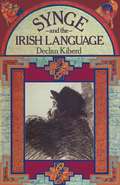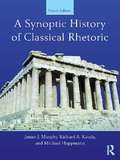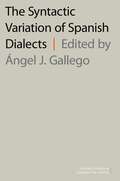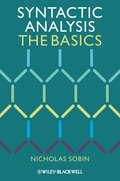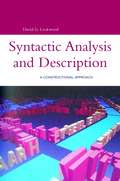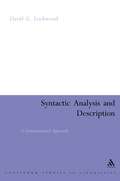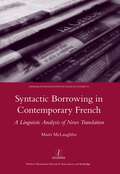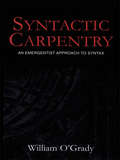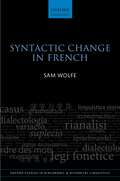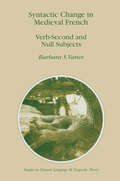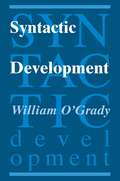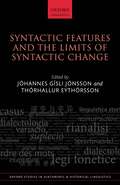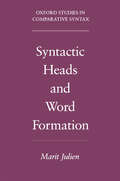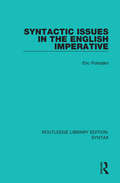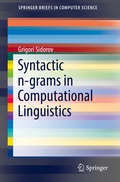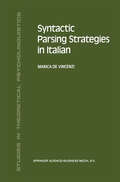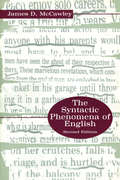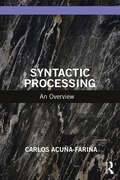- Table View
- List View
Synge and the Irish Language
by Declan KiberdSynge was the victim of a cruel paradox: those who loved his works knew no Irish and those who loved Irish despised his works. This book aims to show that Synge's command of Irish was extensive and that this knowledge proved invaluable in the writing of his major plays.
Synopsis of Javanese Literature 900–1900 A.D. (Koninklijk Instituut voor Taal-, Land- en Volkenkunde #1)
by Theodore PigeaudA Synoptic History of Classical Rhetoric
by James J. Murphy Richard A. Katula Michael HoppmannContinuing its tradition of providing students with a thorough review of ancient Greek and Roman rhetorical theory and practices, A Synoptic History of Classical Rhetoric is the premier text for undergraduate courses and graduate seminars in the history of rhetoric. Offering vivid examples of each classical rhetor, rhetorical period, and source text, students are led to understand rhetoric's role in the exchange of knowledge and ideas. Completley updated throughout, Part I of this new edition integrates new research and expanded footnotes and bibliographies for students to develop their own scholarship. Part II offers eight classical texts for reading, study, and criticism, and includes discussion questions and keys to the text in Part I.
A Synoptic History of Classical Rhetoric
by James J. Murphy Richard A. Katula Michael HoppmannContinuing its tradition of providing students with a thorough review of ancient Greek and Roman rhetorical theory and practices, A Synoptic History of Classical Rhetoric is the premier text for undergraduate courses and graduate seminars in the history of rhetoric. Offering vivid examples of each classical rhetor, rhetorical period, and source text, students are led to understand rhetoric's role in the exchange of knowledge and ideas. Completley updated throughout, Part I of this new edition integrates new research and expanded footnotes and bibliographies for students to develop their own scholarship. Part II offers eight classical texts for reading, study, and criticism, and includes discussion questions and keys to the text in Part I.
SYNTACT VARIAT OF SPANISH DIALECT OSCS C (Oxford Studies in Comparative Syntax)
by Ángel J. GallegoThis book offers a comprehensive overview of the syntactic variation of the dialects of Spanish. More precisely, it covers Spanish theoretical syntax that takes as its data source non-standard grammatical phenomena. Approaching the syntactic variation of Spanish dialects opens a door not only to the intricacies of the language, but also to a set of challenges of linguistic theory itself, including language variation, language contact, bilingualism, and diglossia. The volume is divided into two main sections, the first focusing on Iberian Spanish and the second on Latin American Spanish. Chapters cover a wide range of syntactic constructions and phenomena, such as clitics, agreement, subordination, differential object marking, expletives, predication, doubling, word order, and subjects. This volume constitutes a milestone in the study of syntactic variation, setting the stage for future work not only in vernacular Spanish, but all languages.
Syntactic Analysis: The Basics
by Nicholas SobinHighly readable and eminently practical, Syntactic Analysis: The Basics focuses on bringing students with little background in linguistics up to speed on how modern syntactic analysis works. A succinct and practical introduction to understanding sentence structure, ideal for students who need to get up to speed on key concepts in the field Introduces readers to the central terms and concepts in syntax Offers a hands-on approach to understanding and performing syntactic analysis and introduces students to linguistic argumentation Includes numerous problem sets, helpfully graded for difficulty, with model answers provided at critical points Prepares readers for more advanced work with syntactic systems and syntactic analyses
Syntactic Analysis: The Basics
by Nicholas SobinHighly readable and eminently practical, Syntactic Analysis: The Basics focuses on bringing students with little background in linguistics up to speed on how modern syntactic analysis works. A succinct and practical introduction to understanding sentence structure, ideal for students who need to get up to speed on key concepts in the field Introduces readers to the central terms and concepts in syntax Offers a hands-on approach to understanding and performing syntactic analysis and introduces students to linguistic argumentation Includes numerous problem sets, helpfully graded for difficulty, with model answers provided at critical points Prepares readers for more advanced work with syntactic systems and syntactic analyses
Syntactic Analysis and Description: A Constructional Approach (Open Linguistics)
by David LockwoodThis book is designed to teach undergraduate and beginning graduate students about the varieties of syntactic phenomena in different languages and a method of analyzing and describing them. The method is based on the concept of the syntactic construction, which is shared by various views of language structure. In this particular presentation, a construction is characterized as a combination of obligatory and optional functions, and each of these functions is related to a class of manifestations. Syntax as a whole is then seen as interrelating constructions on the ranks (size-levels) of the phrase, clause, and sentence.Besides the essential features of phrase, clause, and sentence structures, there are chapters devoted to special topics such as clitics, negation, clausal organization, and voice and related devices.While the emphasis is on the actual syntactic structures observable in the data, the relation of syntactic phenomena to linguistic meaning is also considered. In particular, the final chapter shows how account of syntax can often be simplified if control from meaning structure is assumed. Throughout the book, a distinction between meaningfulness and syntactic-well formedness is consistently made.
Syntactic Analysis and Description: A Constructional Approach
by David LockwoodThis book is designed to teach undergraduate and beginning graduate students how to understand, analyse and describe syntactic phenomena in different languages. The book covers every aspect of syntax from the basics to more specialised topics, such as clitics which have grammatical importance but cannot be used in isolation, and negation, in which a construction contradicts the meaning of a sentence. The approach taken combines concepts from different theoretical schools, which view syntax differently. These include M. A. K. Halliday's systemic functional linguistics, the stratificational school advocated by Sydney Lamb, and Kenneth L. Pike's tagmemic model. The emphasis of the book is on syntactic structures rather than linguistic meaning, and the book stresses the difference between a well-formed sentence and a meaningful one. The final chapter brings these two aspects together, to show the connections between syntax and semology.Each chapter concludes with exercises from a diverse range of languages and a list of major technical terms. The book also includes a glossary as an essential resource for students approaching this difficult subject for the first time.
Syntactic Borrowing in Contemporary French: A Linguistic Analysis of News Translation
by Mairi MaLaughlinIt is widely held that the large-scale translation of international news from English will lead to changes in French syntax. For the first time this assumption is put to the test using extensive fieldwork carried out in an international news agency and a corpus of translated news agency dispatches. The linguistic analysis of three syntactic structures in the translations is complemented by an investigation of the effects of a range of factors including, most notably, the speed at which the translation is carried out. The analysis sheds new light on the ways in which news translation could lead to syntactic borrowing in French, and by extension, in other languages.
Syntactic Borrowing in Contemporary French: A Linguistic Analysis of News Translation
by Mairi MaLaughlinIt is widely held that the large-scale translation of international news from English will lead to changes in French syntax. For the first time this assumption is put to the test using extensive fieldwork carried out in an international news agency and a corpus of translated news agency dispatches. The linguistic analysis of three syntactic structures in the translations is complemented by an investigation of the effects of a range of factors including, most notably, the speed at which the translation is carried out. The analysis sheds new light on the ways in which news translation could lead to syntactic borrowing in French, and by extension, in other languages.
Syntactic Carpentry: An Emergentist Approach to Syntax
by William O'GradySyntactic Carpentry: An Emergentist Approach to Syntax presents a groundbreaking approach to the study of sentence formation. Building on the emergentist thesis that the structure and use of language is shaped by more basic, non-linguistic forces—rather than by an innate Universal Grammar—William O'Grady shows how the defining properties of various core syntactic phenomena (phrase structure, co-reference, control, agreement, contraction, and extraction) follow from the operation of a linear, efficiency-driven processor. This in turn leads to a compelling new view of sentence formation that subsumes syntactic theory into the theory of sentence processing, eliminating grammar in the traditional sense from the study of the language faculty. With this text, O'Grady advances a growing body of literature on emergentist approaches to language, and situates this work in a broader picture that also includes attention to key issues in the study of language acquisition, psycholinguistics, and agrammaticism. This book constitutes essential reading for anyone interested in syntax and its place in the larger enterprise of cognitive science.
Syntactic Carpentry: An Emergentist Approach to Syntax
by William O'GradySyntactic Carpentry: An Emergentist Approach to Syntax presents a groundbreaking approach to the study of sentence formation. Building on the emergentist thesis that the structure and use of language is shaped by more basic, non-linguistic forces—rather than by an innate Universal Grammar—William O'Grady shows how the defining properties of various core syntactic phenomena (phrase structure, co-reference, control, agreement, contraction, and extraction) follow from the operation of a linear, efficiency-driven processor. This in turn leads to a compelling new view of sentence formation that subsumes syntactic theory into the theory of sentence processing, eliminating grammar in the traditional sense from the study of the language faculty. With this text, O'Grady advances a growing body of literature on emergentist approaches to language, and situates this work in a broader picture that also includes attention to key issues in the study of language acquisition, psycholinguistics, and agrammaticism. This book constitutes essential reading for anyone interested in syntax and its place in the larger enterprise of cognitive science.
Syntactic Change in French (Oxford Studies in Diachronic and Historical Linguistics #47)
by Sam WolfeThis book provides the most comprehensive and detailed formal account to date of the evolution of French syntax. It makes use of the latest formal syntactic tools and combines careful textual analysis with a detailed synthesis of the research literature to provide a novel analysis of the major syntactic developments in the history of French. The empirical scope of the volume is exceptionally broad, and includes discussion of syntactic variation and change in Latin, Old, Middle, Renaissance, and Classical French, and standard and non-standard varieties of Modern French. Following an introduction to the general trends in grammatical change from Latin to French, Sam Wolfe explores a wide range of phenomena including the left periphery, subject positions and null subjects, verb movement, object placement, negation, and the makeup of the nominal expression. The book concludes with a comparative analysis of how French has come to develop the unique typological profile it has within Romance today. The volume will thus be an indispensable tool for researchers and students in French and comparative Romance linguistics, as well as for readers interested in grammatical theory and historical linguistics more broadly.
Syntactic Change in Medieval French: Verb-Second and Null Subjects (Studies in Natural Language and Linguistic Theory #41)
by Barbara S. Vance1. 0. V2 AND NULL SUBJECTS IN THE HIS TORY OF FRENCH The prototypical Romance null subject language has certain well known characteristics: verbal inflection is rich, distinguishing six per sonlnumber forms; subject pronouns are generally emphatic; and, when there is no need to emphasize the subject, the pronoun is not expressed at all. Spanish and Italian, for example, fit this description rather weIl. Modem French, however, provides a striking contrast to these lan guages; it does not allow subjects to be missing and, not unexpectedly, it has a verbal agreement system with few overt endings and subject pronouns which are not emphatic. One of the goals of the present work is to examine null subjects in two dialects of Romance that fit neither the Italian nor the French model: later Old French (12th-13th centriries) and MiddIe French (14th- 15th centuries). Old French has null subjects only in contexts where the subject would be postverbal if expressed (cf. Foulet (1928)), and Mid dIe French has null subjects in a wider range of syntactic contexts but does not freely allow a11 persons of the verb to be null. The work of Vanelli, Renzi and Beninca (1985) (along with many other works by these authors individually) shows that a number of other geographically proximate medieval dialects had similar systems, though it appears that there are significant differences in detail among them.
Syntactic Development
by William O'GradySyntactic Development presents a broad critical survey of the research literature on child language development. Giving balanced coverage to both theoretical and empirical issues, William O'Grady constructs an up-to-date picture of how children acquire the syntax of English. Part 1 offers an overview of the developmental data pertaining to a range of syntactic phenomena, including word order, subject drop, embedded clauses, wh-questions, inversion, relative clauses, passives, and anaphora. Part 2 considers the various theories that have been advanced to explain the facts of development as well as the learnability problem, reporting on work in the mainstream formalist framework but also considering the results of alternative approaches. Covering a wide range of perspectives in the modern study of syntactic development, this book is an invaluable reference for specialists in the field of language acquisition and provides an excellent introduction to the acquisition of syntax for students and researchers in psychology, linguistics, and cognitive science.
Syntactic Features and the Limits of Syntactic Change (Oxford Studies in Diachronic and Historical Linguistics #43)
This volume brings together the latest diachronic research on syntactic features and their role in restricting syntactic change. The chapters address a central theoretical issue in diachronic syntax: whether syntactic variation can always be attributed to differences in the features of items in the lexicon, as the Borer-Chomsky conjecture proposes. In answering this question, all the chapters develop analyses of syntactic change couched within a formalist framework in which rich hierarchical structures and abstract features of various kinds play an important role. The first three parts of the volume explore the different domains of the clause, namely the C-domain, the T-domain and the ?P/VP-domain respectively, while chapters in the final part are concerned with establishing methodology in diachronic syntax and modelling linguistic correspondences. The contributors draw on extensive data from a large number of languages and dialects, including several that have received little attention in the literature on diachronic syntax, such as Romeyka, a Greek variety spoken in Turkey, and Middle Low German, previously spoken in northern Germany. Other languages are explored from a fresh theoretical perspective, including Hungarian, Icelandic, and Austronesian languages. The volume sheds light not only on specific syntactic changes from a cross-linguistic perspective but also on broader issues in language change and linguistic theory.
Syntactic Heads and Word Formation (Oxford Studies in Comparative Syntax)
by Marit JulienMarit Julien investigates the relation between morphology and syntax, or more specifically, the relation between the form of inflected verbs and the position of those verbs. She surveys 530 languages and shows that, with the exception of agreement markers, the positioning of verbal inflectional markers relative to verb stems is compatible with a syntactic approach to morphology.
Syntactic Issues in the English Imperative (Routledge Library Editions: Syntax)
by Eric PotsdamThis study, first published in 1998, provides a close investigation of central syntactic issues in the English imperative clause type. It argues that the imperative has largely regular syntactic behaviour within a conventional conception of English clause structure. This title will be of interest to students of language and linguistics.
Syntactic Issues in the English Imperative (Routledge Library Editions: Syntax)
by Eric PotsdamThis study, first published in 1998, provides a close investigation of central syntactic issues in the English imperative clause type. It argues that the imperative has largely regular syntactic behaviour within a conventional conception of English clause structure. This title will be of interest to students of language and linguistics.
Syntactic n-grams in Computational Linguistics (SpringerBriefs in Computer Science)
by Grigori SidorovThis book is about a new approach in the field of computational linguistics related to the idea of constructing n-grams in non-linear manner, while the traditional approach consists in using the data from the surface structure of texts, i.e., the linear structure.In this book, we propose and systematize the concept of syntactic n-grams, which allows using syntactic information within the automatic text processing methods related to classification or clustering. It is a very interesting example of application of linguistic information in the automatic (computational) methods. Roughly speaking, the suggestion is to follow syntactic trees and construct n-grams based on paths in these trees. There are several types of non-linear n-grams; future work should determine, which types of n-grams are more useful in which natural language processing (NLP) tasks. This book is intended for specialists in the field of computational linguistics. However, we made an effort to explain in a clear manner how to use n-grams; we provide a large number of examples, and therefore we believe that the book is also useful for graduate students who already have some previous background in the field.
Syntactic Parsing Strategies in Italian: The Minimal Chain Principle (Studies in Theoretical Psycholinguistics #12)
by M. de VincenziThe Syntactic Phenomena of English
by James D. McCawleyThis second edition of James D. McCawley's classic textbook offers in one volume a complete course in the syntactic structure of English. New to this edition are sections on appositive constructions, parasitic gaps, contrastive negation, and comparative conditional sentences, as well as expanded coverage of cleft sentences and free relatives. The presentation is coherent, comprehensive, and systematically organized, beginning with an overview of McCawley's approach to syntactic analysis and progressing through the major constructions and processes of English grammar. No prior special knowledge of syntax is presupposed, and the number and variety of exercises after each chapter have been increased. And now available from the author! Answers to Selected Exercises. Instructors using James D. McCawley's The Syntactic Phenomena of English, Second Edition may request a complimentary copy of Answers to Selected Exercises in The Syntactic Phenomena of English by writing on their department's letterhead to the author, James D. McCawley, Department of Linguistics, 1010 E. 59th Street, Chicago, IL 60637. [Note: This material is available only from the author and is not available from the University of Chicago Press.]
Syntactic Processing: An Overview
by Carlos Acuña-FariñaThis book provides an overview of the structures, topics and main theories of syntactic processing. It covers the last 40 years of sentence-level psycholinguistic research and debates and makes it accessible to both theoretical linguists and experimental psychologists. Tying linguistically relevant issues to psycholinguistic theory, this book: Covers the processing of the grammatical phenomena adjunction, agreement and gap filling and discusses the relationship between grammars and parsers Discusses experimental work and theories, demonstrating how psychologists have made real strides in understanding language and how studying the processing of syntactic structure is the same as studying the nature of language Explores the key theories of psycholinguistics, including recent developments Explains the different methodologies of sentence processing, such as eye-tracking and electroencephalography Bridging the gap between psycholinguistic research and the study of language, this book is essential reading for advanced students and scholars of linguistics and experimental psycholinguistics as well as cognitive science and psychology.
Syntactic Processing: An Overview
by Carlos Acuña-FariñaThis book provides an overview of the structures, topics and main theories of syntactic processing. It covers the last 40 years of sentence-level psycholinguistic research and debates and makes it accessible to both theoretical linguists and experimental psychologists. Tying linguistically relevant issues to psycholinguistic theory, this book: Covers the processing of the grammatical phenomena adjunction, agreement and gap filling and discusses the relationship between grammars and parsers Discusses experimental work and theories, demonstrating how psychologists have made real strides in understanding language and how studying the processing of syntactic structure is the same as studying the nature of language Explores the key theories of psycholinguistics, including recent developments Explains the different methodologies of sentence processing, such as eye-tracking and electroencephalography Bridging the gap between psycholinguistic research and the study of language, this book is essential reading for advanced students and scholars of linguistics and experimental psycholinguistics as well as cognitive science and psychology.
